Executive Summary
The longevity annuity has become increasingly popular in recent years as a potential new vehicle for retirement income, as its ability to delay payments to an advanced age like 85 allows for a significant accumulation of mortality credits. And since the introduction of last year’s Treasury Regulations, a so-called “Qualified Longevity Annuity Contract” (QLAC) can even be purchased inside of an IRA or other retirement account, allowing a portion of a retiree’s RMDs to be deferred from 70 ½ to as late as age 85!
However, as it turns out the unique nature of a longevity annuity’s payment structure is not very hospitable as an RMD deferral strategy. The fact that it can take until a retiree’s late 80s just to break even and recover principal means the retiree risks significant foregone growth by trying to merely defer RMDs through the use of a QLAC. And of course, the RMDs will still eventually happen anyway, as the QLAC merely defers when payments begin. In fact, ironically, if the retiree does live, the accelerated payments of a QLAC in the later years can actually deplete an IRA even faster than normal IRA RMDs would have anyway!
Ultimately, this doesn’t mean that the longevity annuity (or a QLAC inside an IRA) is a bad deal. The ability to accumulate mortality credits still means it can be very effective as a fixed income alternative for those who fear they may not have enough money to fund a retirement well beyond their life expectancy. And if retiree intends to spend all of his/her assets anyway, and the only available dollars for retirement are held in an IRA or other retirement account, the QLAC is an effective means to engage in such a strategy. Nonetheless, the bottom line is that while a QLAC may be a valid way to use a retirement account to hedge against longevity – and defer RMDs along the way – it’s still not very effective as an RMD avoidance or deferral strategy! Just because you can buy a longevity annuity inside a retirement account as a QLAC doesn't mean you should!
What Is A Longevity Annuity (a/k/a the "Deferred Income Annuity" [DIA])?
The basic concept of a longevity annuity is that, like an immediate annuity, a lump sum payment is made in exchange for guaranteed payments (typically for life) in the future. The difference is that while the lifetime payments from an immediate annuity start immediately – as the name implies – with a longevity annuity the onset of those payments is deferred until some point in the future (and thus is also known as a “Deferred Income Annuity” [DIA]).
For instance, a 65-year-old couple today could put $100,000 into a single premium immediate annuity and get (level) payments of almost $6,000/year for life, but if the couple was willing to wait until age 85 to get the first payment, the subsequent payments would be nearly $32,000/year for life instead! The good news of this approach is that the payments in the later years are dramatically larger with a longevity annuity than an immediate annuity. The bad news, of course, is that you have to wait 20 years to get the first check!
Even when adjusting for the waiting period and the time value of money, though, the reality is that in the long run (for those who actually do live a long time), a longevity annuity’s payments provide a better internal rate of return (IRR) than an immediate annuity. In other words, while the longevity annuity buyer is at risk for a greater loss in the early years (since it may take 20 years just to get the first payment!), those greater payments pay off in the long run with a superior implied return (for those who actually live long enough to see them!).
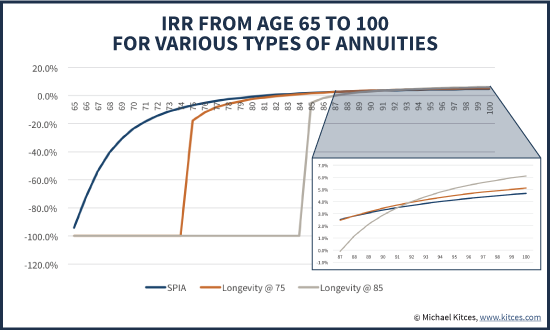
Longevity Annuities, The Required Minimum Distribution (RMD) Rules, And The QLAC
While the trade-off of a longevity annuity may be appealing for retirees, the situation gets more complicated if the only dollars available to purchase such an annuity are inside retirement accounts, like an IRA or a 401(k) plan. The problem is that by its nature, a longevity annuity doesn’t begin payments until a distant point in the future – such as at the advanced age of 85 – and this presents a serious conflict when the standard rules for retirement accounts require that minimum distributions begin beyond age 70 ½! In other words, it’s hard to start taking RMDs at 70 ½ when the longevity annuity payments aren’t even scheduled to begin until nearly 15 years beyond that point!
Technically, it would be possible to still calculate a present value of the expected future longevity annuity payments, in order to calculate what an RMD would be – and then take that RMD from other available retirement account assets, since the IRA aggregation rule does allow RMDs to be taken from any account. But given that longevity annuities typically have no liquidity until the payments begin, if too much is invested into the contract, and/or the other retirement account assets are spent down too quickly, the retiree could still be stuck in a liquidity squeeze where there are no retirement dollars available outside the longevity annuity to cover the next RMD when it is due!
To resolve the issue, last year the Treasury issued new regulations under 1.401(a)(9)-6, declaring that a “Qualified Longevity Annuity Contract” (or “QLAC” for short) could be owned inside of a retirement account, and automatically have its payments (which still might not begin until after age 70 ½) be deemed to satisfy the RMD rules. In order to be a “qualified” longevity annuity eligible to be held inside a retirement account, though, the new rules required that only 25% of retirement accounts can be invested into a QLAC, the cumulative dollar amount invested into QLACs cannot exceed $125,000, the QLAC still cannot defer payments beyond age 85 (i.e., age 85 is the latest possible start date), and the QLAC cannot have a liquid cash surrender value (i.e., it must be irrevocable and illiquid, although it can still have a return-of-premium death benefit payable to heirs).
The establishment of the QLAC rules relieves the need for a retiree to keep other retirement dollars available and liquid to meet any RMD requirements associated with the longevity annuity. Instead, the longevity annuity payments themselves – even if not beginning until age 85 – are automatically deemed to satisfy the retiree’s RMD obligations for the funds in the longevity annuity (so only the other remaining retirement accounts must deal with RMDs, which would come from those accounts). And to limit the potential tax advantages – since the QLAC rules essentially allow someone to defer RMDs from age 70 ½ until age 85! – the Treasury limited both the maximum dollar amount and the percentage of retirement accounts that can be allocated from such retirement accounts into a QLAC.
On the one hand, the issuance of the QLAC regulations meant that retirees who wanted to own a longevity annuity but only had retirement account dollars available now had a means to do so (without worrying about liquidity issues for satisfying RMDs). On the other hand, the QLAC regulations also introduce the potential of using a QLAC specifically as an RMD avoidance (or at least, deferral) strategy. But is a QLAC actually a good way to delay the onset of RMDs?
The Problem With Using A QLAC To Avoid RMD Obligations
While it may appear intuitively appealing to use a QLAC to defer RMDs from age 70 ½ out as late as age 85, there is an important caveat to consider – delaying payments until age 85 also means that the retiree doesn’t get the money back until that point, either! And in fact, even when the payments begin, it takes several years for the payments just to add up to the original principal. Which means the retiree may be deferring RMDs along the way, but in a pure economic sense, must also live until his/her late 80s just to break even and recover the original principal!
And unfortunately, the problem is that’s not even an odds-on bet! For instance, the chart below shows the survival rates (using the Health Annuitant RP-2014 Mortality Tables from the Society of Actuaries) for a 69-year-old single male or single female (i.e., as QLAC purchases from a single person’s IRA will typically be single life, and the buyer would ostensibly make the purchase at age 69 to avoid the onset of RMDs at age 70 ½). Given that the longevity annuity payment beginning at age 85 would be $36,920/year or $32,606 (for males and females, respectively), such that the buyer must survive to roughly age 88 merely to break even, these results reveal that there’s a barely 50% chance that the 69-year-old QLAC buyer even lives long enough to recover his/her principal! In other words, the retiree has to live to or beyond life expectancy just to get enough QLAC payments to get their principal back!
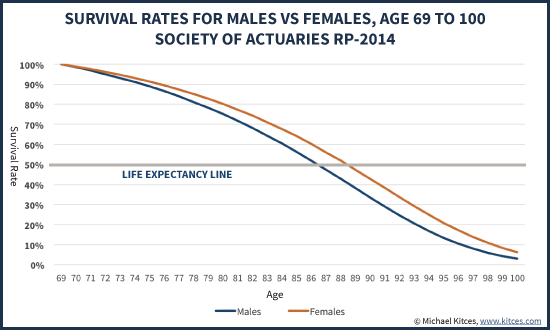
And of course, the reality is that even if a QLAC buyer does live long enough to recover principal, that’s still a significant “loss” in opportunity cost; at an 8% growth rate, an investment would quadruple in value over a comparable roughly-18-year time horizon! So merely getting the principal back after 18 years is not exactly an accomplishment, even if it did allow for RMDs to be deferred along the way.
In fact, the chart below shows the value of a $100,000 QLAC purchase (assuming it has a return-of-principal death benefit guarantee, so its “minimum” value will always be the original starting amount, less taxes), versus the value of a $100,000 retirement account (e.g., a traditional IRA) that simply stays invested at 8%, takes the RMDs as compelled to do so, and reinvests the proceeds in a taxable account. The RMDs are assumed to be taxed at 25% (and in order to evaluate comparable “after-tax” spendable values, any remaining pre-tax value of the QLAC or IRA is also haircut at 25% to ensure an apples-to-apples after-tax-wealth comparison). Growth on the funds already pushed into the taxable account (from RMDs that have occurred, or QLAC payments once they have occurred) are assumed to be taxed at 20% annually, a combination of taxing ordinary income interest and preferential long-term capital gains and qualified dividends.
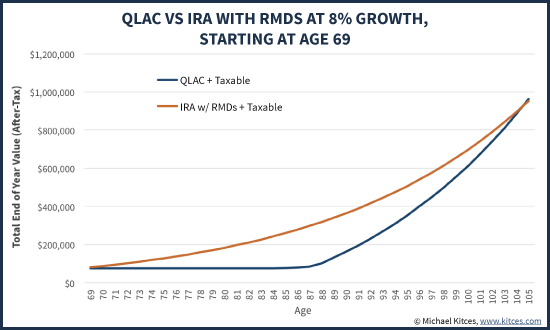
As the chart reveals, using a QLAC to avoid RMDs is indeed a losing proposition. While the RMD payments may be delayed, the reality is that the QLAC still forces money out of the IRA as well, and in the later years does so even faster than RMDs would have. And in the meantime, the IRR on a QLAC is still "only" about 6% to age 100, while a balanced account can potentially grow closer to 8%, which means the QLAC just lags further and further behind in the initial years. Accordingly, as the chart shows, the retiree must live to age 105 for the QLAC to generate as much wealth as simply keeping the IRA, taking the RMDs, paying the taxes, and reinvesting the proceeds!
On the other hand, for the retiree who 'merely' lives to life expectancy, the loss of using a QLAC to avoid RMDs is dramatic. Even with a return-of-premium death benefit guarantee, at even a healthy retiree life expectancy around age 88 the retiree has merely recovered principal, while the IRA-plus-taxable-account-funded-with-RMDs would be up to more than $300,000 even after taking a haircut for IRA taxes. And in fact, the IRA would still have over $160,000 in the account on a gross basis by then - more than the original $100,000! - which would be available for beneficiaries to stretch, which means the IRA-plus-taxable-account would actually fare even better than the graphic implies (unless Congress eliminates the stretch IRA, of course!)! By contrast, the QLAC buyer will only be leaving behind non-tax-deferred investments in a brokerage account (as any remaining pre-tax payments cease when the QLAC annuitant passes away)! Which means ultimately, while a QLAC does avoid some RMDs in the retiree’s 70s and 80s that the IRA would have triggered, it also forgoes significant growth during that time period, and in the later years the QLAC effectively liquidates the IRA even faster during the retiree’s 90s! In fact, as shown below, the QLAC always leaves behind less of an IRA to stretch than just keeping the IRA and taking the RMDs!
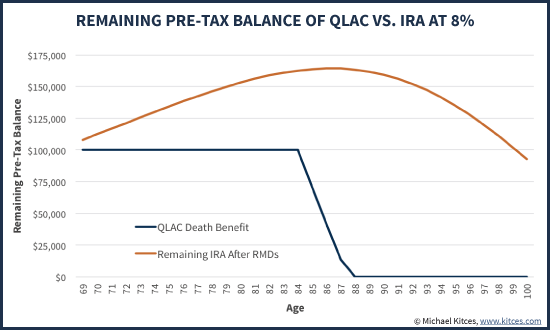
Notably, the inferior result of the QLAC is ultimately driven both by the fact that the level of tax deferral for a QLAC isn't actually that significant (after all, it's not tax avoidance, it's just tax deferral), and that a QLAC simply doesn't have that great of an internal rate of return for those who live to life expectancy, especially when compared to an IRA invested in a balanced portfolio. On the other hand, if the IRA is invested more conservatively as well - such that the QLAC is at least somewhat more competitive on a head-to-head investment basis, thanks to mortality credits - the QLAC fares at least a little better. Still, though, even when the IRA returns are "just" 5%, the QLAC still doesn't pull ahead until the retiree reaches age 93, an age that even amongst healthy retiree annuitants only 20% of 69-year-old males and 29% of 69-year-old females are expected to reach (i.e., it's still not an odds-on bet!).
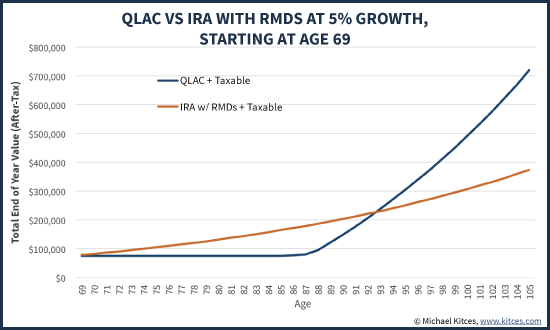
When A Longevity Annuity Still Makes Sense As A QLAC In A Retirement Account
Notwithstanding the issues with using a QLAC as a means to defer RMDs, it’s not necessarily a bad deal altogether to buy a longevity annuity inside of an IRA (or other retirement account) as a QLAC. If the purpose of the QLAC is specifically for retirement income to spend, and makes sense as a part of the entire retirement income picture, a QLAC is still a reasonable approach (though notably, still inferior to delaying Social Security!).
For instance, as noted previously on this blog, lifetime annuities in general will provide more retirement income than a bond alone over a comparable time horizon, thanks to mortality credits. And as shown earlier, if the goal is to generate strong lifetime payments with big mortality credits, longevity annuities provide an even better internal rate of return in the long run than a traditional single premium immediate annuity. In other words, if the retiree is going to hold fixed-income investments anyway, and wants to hedge against a long life, lifetime immediate annuities are better than bonds, and longevity annuities are better than immediate annuities… and if the available dollars for such a transaction happen to be inside of an IRA, so be it, the longevity annuity will simply be a QLAC. (Notably, though, longevity insurance is far less compelling as an alternative to stocks.)
Similarly, if the reality is that the retiree primarily intends to spend all the available dollars during life, and doesn’t necessarily have legacy goals, there may not be any intention to leave a remaining IRA balance behind… in which case, the fact that a QLAC will accelerate distributions out of the IRA in the retiree’s 90s isn’t a negative but simply a reality of getting the needed cash flows for retirement, and the loss of a stretch IRA for the next generation is a moot point because there isn’t any plan to leave an inherited IRA in the first place!
Ultimately, then, the key point is that if a longevity annuity is appealing to buy for retirement income and longevity hedging purposes - especially as a fixed income alternative - and the available dollars to buy it are within an IRA or other retirement account, there’s nothing wrong with using those retirement dollars and buying a QLAC, and getting the RMD deferral along the way. But if the goal is to defer RMDs in the first place, the value proposition of the QLAC isn’t very compelling, as the retiree takes on a significant risk of losing out on almost two decades’ worth of compounding growth just to defer RMDs, only to find that if he/she lives the QLAC distributions in the client’s 90s will be even more severe than the RMDs ever would have been… and may even be giving up economic growth along the way as well, if the retiree simply could have invested in a balanced portfolio over that multi-decade time horizon!




